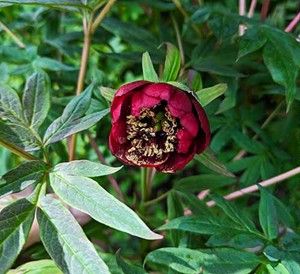#371 (Sh.E2) DELAVAY PEONY
Paeonia delavayi

Planted: 1999
This shrub is at the eastern end of the moat path, near the brick steps.
| Distribution: | Endemic to southwest China, where it is limited to Sichuan, Yunnan and the extreme southeast of Tibet at 2000-3600 m altitude. |
| Planting Date: | Donated by Cliff Baker in 1999 as a seedling. |
| Growth Habit: | variable in the number and shape of the leaflets and in the number, size, and colour of all parts of the flower both within and between populations. |
| Bark: | |
| Leaf: | |
| Cones: | |
| Seeds: | Almost exclusively reproduces through stolons, and seedlings are rare to find. This allows for rapid colonization after a seed has arrived at a new location, such as on newly stabilised debris. |
| Uses: | Cultivated as an ornamental. In China, it is cultivated to produce a traditional medicine. Listed as endangered in the China Plant Red Data Book. May be under threat if digging out roots for medicine on a large scale is not adequately controlled. However, because it easily reproduces vegetatively and is relatively widely distributed, it may not go extinct. Provided exploitation of the root for medicine is adequately controlled. |
| Introduction Date: | First described by Delavay in 1896 but not recognised as a species until 1979. |
| Anecdotes and Comments: | Named after Father Père Jean-Marie Delavay (1834 – 1895) French missionary, explorer and botanist. |